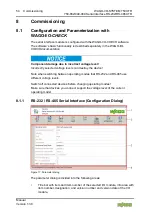
WAGO-I/O-SYSTEM 750 XTR
Function Description 39
750-652/040-000 Serial Interface RS-232/RS-485 XTR
Manual
Version 1.3.0
If continuous transmission is activated, the I/O module evaluates the bit SC in
control byte 0. Only when SC takes the value 1 does the I/O module transmit the
data contained in the output buffer to the serial interface. The application can set
SC to 0 to prompt the I/O module to accumulate data in the output buffer.
5.1.2
Receive Data
If the I/O module receives data via an RS-232, RS-485 or RS-422 interface, the
data is written to the input buffer of the I/O module. The I/O module transfers data
to the application consecutively long as there is data in the input buffer. The I/O
module writes the respective part of the data to the data bytes of the process
image. The I/O module modifies the status bytes. Based on these modified status
bytes, the application can recognize that new data has been received, which it can
then evaluate. The application modifies the control bytes, so that they signal to the
I/O module that the data transfer was successful. Only when this feedback is
present can the I/O module transmit the next part of the data received.
5.1.2.1 Continuous Receipt
If there is data in the input buffer, the I/O module can be set either to begin
transmitting data to the application immediately or to wait to receive additional
data.
If the I/O module begins to transmit data to the application immediately, only part
of a contiguous message may have been received by that point. Whether a
message has been transmitted on the serial interface according to time criteria is
then no longer evident for the application.
Example: A serial device transmits 20 bytes. After the I/O module has received
1 byte, it begins to transmit the date to the application. The I/O module transmits
the remaining 19 bytes received in the meantime only after the application has
confirmed receipt of the first byte.
If continuous receipt is activated, the I/O module begins transmitting data to the
application only if no additional data has been received on the serial interface for a
specific period of time. In the example above, the I/O module would only start
transmitting data to the application when all 20 bytes have been received.
The time period after which the I/O module starts data transmission can be defined
using the “Continuous Receive Timeout” parameter. Because the duration of the
transfer of any amount of data depends on the baud rate setting, number of data
and stop bits and the parity, an absolute time specification is not feasible.
Therefore, the time required to transmit exactly one character to the serial interface
in the current interface parameter setting is used as the unit of measurement.
















































